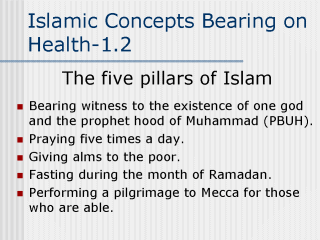| front |1 |2 |3 |4 |5 |6 |7 |8 |9 |10 |11 |12 |13 |14 |15 |16 |17 |18 |19 |20 |21 |22 |23 |24 |25 |26 |review |
 |
Muslims
religious commitment to the five pillars gives an opportunity not only for psychodynamics
of rituals, belief and faith but also encourages the establishment of social support and
the following of a health conducive lifestyle. In turn these pathways as hypothesized by
Levin (1996) in table 1 (3rd Slide) could lead to lower disease risk and
enhanced well-being through a salutogenic mechanism. The next five slides will expound further on these five pillars of Islam. For each pillar, its link towards health will be explained. References: Levin, J. S. (1996). How religion influences morbidity and health: Reflections on natural history, Salutogenesis and host resistance. Social Science Medical Journal, Vol 43, No 5, 849-864. |